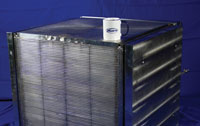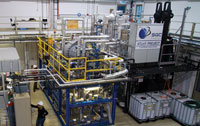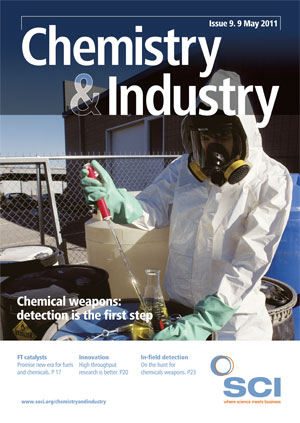Fischer-Tropsch (FT) synthesis, invented over 80 years ago by two German chemists, is undergoing a revival that could create a global market for its catalysts of over $3bn/year.
However, developers of FT catalysts will have to overcome formidable challenges if the technology is to be widely accepted as a way of making fuels and chemicals.
In the 1920s, Franz Fischer and Hans Tropsch discovered that paraffin hydrocarbons could be produced by passing carbon monoxide and hydrogen over cobalt or iron based catalysts. It was already known that oxides of carbon could be converted into methane by catalytic conversion. Fischer and Tropsch found that ethane, propane and longer-chain carbons could be made if the synthesis is carried out at a lower temperature and a slightly increased or lower pressure.
The technology was not fully commercialised until the late 1930s, whereupon Germany used it to convert coal into fuels during World War II. Then in the 1950s, in the drive to achieve energy self-sufficiency in the face of international sanctions resulting from its apartheid policy, South Africa developed the technology further to make both fuels and petrochemicals.
Now a range of projects based on FT has been launched around the world, with the objective of employing the technology for making fuels and chemicals from a source other than crude oil, in particular from gas, coal and biomass. FT has the advantage of not only being able to provide high quality, clean fuel but also a wide variety of chemicals. By the late 1990s, the South African oil, gas and chemicals company Sasol was producing around 200 different fuel and chemical products by Fischer-Tropsch synthesis.
The manufacture of FT catalysts is now an emerging industry, which seems destined to transform catalyst design, production and application. It is likely to bring in a new era of tailor-made catalysts for mass fuels and chemicals production. Over the next two decades, fuels with a range of chemical co-products using Fischer Tropsch synthesis for making gas-to-liquid (GTL), coal-to-liquid (CTL) and biomass-to-liquid (BTL) are poised to become the world’s fastest growing energy segment. By 2030, there could be GTL capacity of several million barrels of day of oil equivalent, against around 300,000bbl/day in 2011, close to 2mbbl/day of CTL and a few million bbl/day of BTL.

The types and nature of the catalysts used in FT synthesis determine the technologies employed throughout the whole process – from the pretreatment of the feedstock; its gasification into carbon monoxide and hydrogen or syngas; the purification of the syngas; the FT synthesis itself; and the upgrading of its crude output into fuels and chemicals.
Difficulties in achieving the right balance between the different stages is a major reason why many FT projects are taking time to reach the commercial stage.
Currently, outside South Africa, there are few FT plants in full industrial-scale operation producing fuels, lubricants and chemical feedstocks from coal and gas, let alone biomass. The vast majority of BTL schemes in particular are in the pilot or demonstration phase.
The biggest of the FT projects – Shell’s Pearl GTL in Qatar, which is scheduled to become fully operational next year with a capacity of 260,000bbl of oil equivalent/day of fuels, lubricants and naphtha – received its first flow of dedicated gas in March 2011 (see picture on page 17 and below). Its proprietary cobalt-based catalyst system has taken around 30 years to develop, and prototypes of it have been in commercial-scale application in a much smaller GTL facility at Bintulu, Malaysia, since 1993.
The amounts of gas from Qatar’s giant North Field in the Arabian Gulf, which will be processed annually by the GTL plant, will amount to 8% of Shell’s total gas production. Andy Brown, the company’s country chairman in Qatar, has described the scheme as ‘a foundation for Shell’s future growth for decades to come’. However, it requires huge amounts of intricately structured catalysts. CRI/Criterion, Shell’s catalyst company, has spent four years of full-time production in dedicated European plants making the thousands of tons of catalysts for the first few years of its operation before they have to be replaced by another enormous batch. The catalysts are distributed around tens of thousands of narrow tubes in 1400-tonne reactors in the FT plant.
The Pearl GTL scheme employs a multi-tubular fixed-bed technology, one of four main types of large FT reactors, the others being circulating fluidised bed, fixed fluidised bed and fixed slurry bed. Each type has its own catalyst requirements. FT reactions are performed at pressures of 20–40bar and temperatures of a low level of 200-250oC and a high one of 300-350oC. Iron catalysts are generally applied in the higher temperature range to produce olefins and cobalt the lower one to provide longchained products. Iron catalysts can be considerably cheaper than cobalt ones, while the cost of both can be boosted by the use of noble metal promoters.
FT catalyst systems have different syngas requirements, which can affect the choice of gasification technologies and vice versa. Iron catalysts, for example, need a lower H2/CO ratio than cobalt. But the ratio can be adjusted with the addition of water-gas-shift technology, which reacts part of the CO with steam to produce more hydrogen.
Perhaps the biggest problem with FT catalysts is their vulnerability to contamination. Deactivating poisons include hydrocarbons, nitrogen, sulphur, halides, alkali metals, tars and particulates. Contaminants should be removed from the syngas through cleaning equipment, which can raise the front-end capital costs of the process. Gasification and purification units can amount to 60–70% of capital costs, with those of the FT plant itself accounting for less than 30%. However, the catalysts make up a much higher proportion of the running costs, hence the need to keep deactivation levels as low as possible.
New or improved gasification and cleaning technologies are enabling FT catalyst systems to operate more effectively, particularly with biomass and the relatively new feedstock option of municipal solid waste (MSW). The VTT Technical Research Centre in Finland has developed an Ultra- Clean Gas technology, which is being tested in a joint venture demonstration gasification and FT facility at Varhaus, Finland, of Neste Oil and Stora Enso, the pulp and paper producer, for converting wood into diesel and co-products.

The biggest impetus for enhancements in the performance of FT catalysts has been advances in imaging technologies, such as microscopy and spectrometry, which have enabled scientists to characterise catalyst particles and pores from tens of microns to a few nanometres in size. They can even be analysed at the level of single atoms. Johnson Matthey, the UK-based catalyst manufacturer, has used a Scanning Transmission Electron Microscopy (STEM) unit at Daresbury Laboratory in northwest England to study the exact distribution of promoter atoms on FT cobalt catalysts. The analysis has led to ‘improved understanding’ of promoter atoms, which will be of ‘great value in the design of new catalysts’, according to Peter Ash, a scientist at Johnson Matthey Technology Centre, Sonning Common, UK.
The use of imaging technologies is enabling the introduction not only of more effective promoters but also supports for the distribution of smaller catalytic particles over a larger surface area. The more surface area there is, the more effective the catalyst, according to Carl Mesters, Shell’s chief scientist for chemistry and catalysis. The total surface area of the cobalt-based catalysts being applied in the Pearl GTL projects is almost 18 times the 11,437km2 territory that is Qatar. The surface expanse comes from the many nano-sized inner channels and pores in the catalyst support structure.
Shell and Sasol are among the few oil and gas players with both the financial clout and technology to set up large FT projects. However, another option, which is currently showing bright prospects, is FT microchannel and microreactor plants. These have advantages for both localised BTL plants and offshore conversion of natural gas. ‘There is enormous potential for microchannel reactors with a tremendous number of deals out there to be reached in the GTL and BTL areas,’ says Jeff McDaniel, business development manager at Velocys, the US-based subsidiary of the UK’s Oxford Cxatalysts.
Oxford Catalysts has just finished building its first commercial scale microchannel reactor for SGC Energia (SGCE) of Portugal with which it is involved in a BTL demonstration scheme at Gussing, Austria. It also has a partnership with Petrobras, Brazil’s national oil company, for a demonstration unit in Brazil for the GTL conversion of offshore flared gas. CompactGTL, currently Oxford Catalysts’ main competitor in the micro segment with a pilot plant at Wilton, England, also has an alliance with Petrobras for the operation of an offshore GTL demonstration plant.
One advantage of microchannels, which are just 5-10mm diameter in the Oxford Catalysts units, is that cobalt catalysts are much more active than in the conventional plant. This can make them eight to 15 times more productive. ‘At the moment, it appears that in order to be economical, FT plants have to be very large like Pearl GTL or very small,’ says McDaniel. ‘The ones that still have to prove themselves are the ones in the middle.’
Sean Milmo is a freelance writer based in Braintree, Essex, UK.





